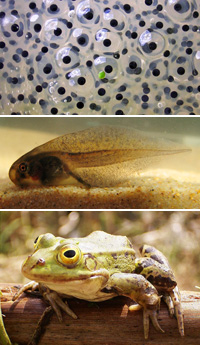
Illustrated by: Sabine Deviche
Metamorphosis: The Ultimate Transformer

Imagine if your body could change its shape and the things it could do. You might start out walking on the ground with two legs and then later develop wings to fly. Maybe you begin your life with gills and fins so you can breathe and swim under water and then later grow a set of lungs and legs so you could live on dry land. Does this sound like a fantastic and unbelievable story to you? It isn’t. Every day there are animals that make these types of changes as part of a process called metamorphosis.
What does Metamorphosis Mean?
The word “metamorphosis” comes from the Greek and means to transform. There are a lot of examples of this type of change. Frogs start out as eggs, then become tadpoles before becoming adults. Fish, such as salmon, must transform so they can move from fresh water to salt water and back to freshwater. Both of these changes are impressive, but maybe the most amazing animal transformation happens in the insect world. For some insects it is possible to begin life crawling and eating and later change into a flying animal. In fact, many insects experience extreme changes as they grow and develop to become adults.

People change too, but our development is not as impressive as that of insects. Humans have a skeleton on the inside of their bodies, where the bones can grow longer and thicker as they get older. Insects have an exoskeleton, which means that their skeleton is on the outside of their body. An exoskeleton is made of chitin which is a strong and hard material. Unlike human skin, chitin is not stretchy and insects must make new skeletons as they grow larger. To do this, they will grow and change as they go through different stages. This transformation is called a metamorphosis.
There are Two Types of Metamorphosis
Most insects begin life as an egg and hatch within a few days of being laid. But there are some insects that will live through an entire season as an egg before hatching. The insects that stay in the egg longer need more time to grow and become strong enough to live outside of the egg. When the temperature becomes warm and comfortable these tiny insects will break out of their eggs and, depending on the species, will go through an incomplete or a complete metamorphosis. Below is a table with the two types of metamorphosis and a list of some of the insects that go through each form of development.
Incomplete Metamorphosis |
Complete Metamorphosis |
|
|
|
Table listing animals that go through incomplete or complete metamorphosis.
Read more about: Metamorphosis – Nature’s Ultimate Transformer
Bibliographic details:
- Article: Metamorphosis – Nature’s Ultimate Transformer
- Author(s): Page Baluch
- Publisher: Arizona State University School of Life Sciences Ask A Biologist
- Site name: ASU - Ask A Biologist
- Date published: 29 Apr, 2011
- Date accessed:
- Link: https://askabiologist.asu.edu/explore/metamorphosis
APA Style
Page Baluch. (Fri, 04/29/2011 - 10:01). Metamorphosis – Nature’s Ultimate Transformer. ASU - Ask A Biologist. Retrieved from https://askabiologist.asu.edu/explore/metamorphosis
Chicago Manual of Style
Page Baluch. "Metamorphosis – Nature’s Ultimate Transformer". ASU - Ask A Biologist. 29 Apr 2011. https://askabiologist.asu.edu/explore/metamorphosis
Page Baluch. "Metamorphosis – Nature’s Ultimate Transformer". ASU - Ask A Biologist. 29 Apr 2011. ASU - Ask A Biologist, Web. https://askabiologist.asu.edu/explore/metamorphosis
MLA 2017 Style

Moths go through complete metamorphosis, living part of their lives as larva before becoming adults.
Be Part of
Ask A Biologist
By volunteering, or simply sending us feedback on the site. Scientists, teachers, writers, illustrators, and translators are all important to the program. If you are interested in helping with the website we have a Volunteers page to get the process started.


